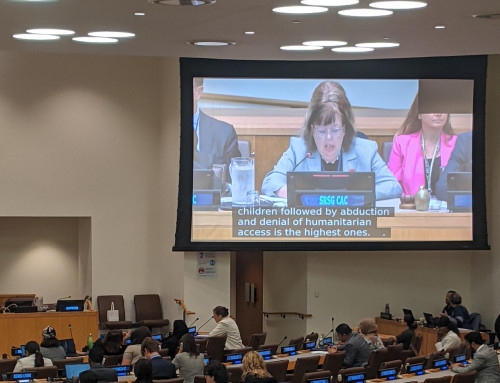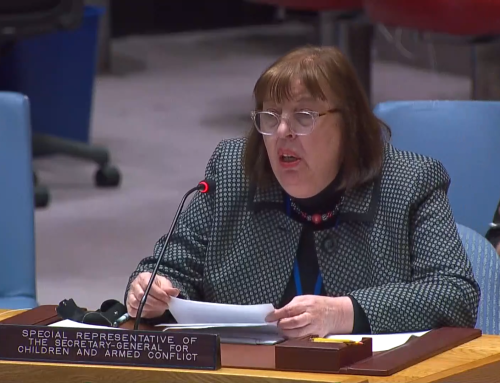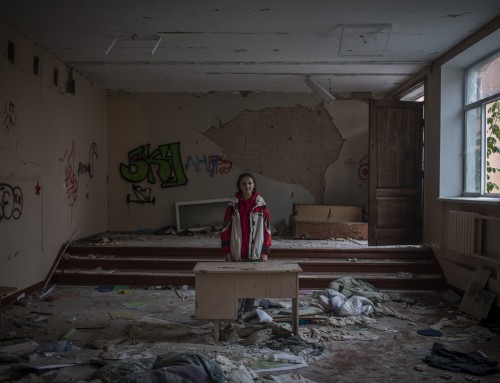14 January 2003
Statement to the Security Council
Statement in the
UN SECURITY COUNCIL
on the occasion of Open Debate on
CHILDREN AND ARMED CONFLICT
by Olara A. Otunnu
Under-Secretary-General
Special Representative of the Secretary-General
for Children and Armed Conflict
Tuesday, 14 January 2003
New York
Mr. President,
It is very good to see you back at the United Nations and back in the Security Council. Your previous engagement and leadership in this arena left a well-deserved mark that precedes you on this occasion. We are very grateful for the leadership that France has been providing in the Council on the agenda for the protection of children affected by armed conflict (CAAC ). We recall that, but for the terrorist attack of September 2001, the Security Council had planned to hold a special summit that month devoted to CAAC, at the initiative and under the leadership of President Jacques Chirac. We also recall that France played a key role in drafting SCR 1379 (2001), which created the basis for the list under discussion today.
Building a normative framework for protection
Since the Security Council formally affirmed that the protection and well-being of children exposed to armed conflict constitutes a fundamental peace-and-security concern (SCR 1261 {1999}), which belongs to its agenda, the progressive engagement of the Council has yielded significant gains for children. These include: the three resolutions to-date devoted to this issue; an annual review and debate on CAAC; incorporation of child protection into peacekeeping mandates and training; inclusion of CAAC concerns in country-specific reports; creation of the role and deployment of Child Protection Advisers (CPAs) in peacekeeping operations; inclusion of children's concerns in peace negotiations and accords; direct participation of children in the deliberations of the Security Council; increasing focus on children in post-conflict programmes in situations such as Kosovo, Sierra Leone and Afghanistan; and regular engagement with NGOs in the context of 'Arria formula' consultations.
I congratulate the Council for these important achievements.
Parallel to these developments in the Council, tremendous progress has been made over the last few years to strengthen and codify international norms and standards for protecting CAAC. Key international instruments that have entered into force over this period include:
The Optional Protocol on the involvement of children in armed conflict which requires State parties to set an age limit of 18 years for compulsory recruitment and direct participation in hostilities and non-state parties are required not to recruit or use children below 18 years of age.
The Rome Statute creating the International Criminal Court which classifies recruitment or use in hostilities of children under 15, intentional attacks on schools and hospitals, and grave acts of sexual violence, as crimes of war.
International Labour Organization (ILO) Convention 182 which classifies child-soldiering as one of the worst forms of child labour and sets 18 as the minimum age for compulsory recruitment.
The African Charter on the Rights and Welfare of the Child, which prohibits recruitment or direct participation in hostilities of persons under the age of 18.
Embarking on an 'era of application.'
We now have in place a very impressive body of norms and standards. We have in place a comprehensive set of principles and measures set out in the three Security Council resolutions. A lot of progress has been achieved outside the framework of the United Nations, particularly through advocacy and activities of NGOs and other civil society organizations and regional organizations. And there has been a significant rise in public and official awareness concerning CAAC.
We have reached a critical juncture in the development of CAAC agenda. With these gains in place, what should be the next steps in the development of this agenda? The most pressing challenge facing us collectively is how to translate the principles, standards and measures that have been put in place into facts on the ground, into a protective regime that can save children in danger. For this, it is imperative to embark on an 'era of application.' And the Security Council is well-placed to lead the way by its example and action.
As we embark on an 'era of application,' two issues above all will test our collective resolve to make a real difference on the ground.
First, we need to ensure systematic monitoring and reporting on the conduct of parties to conflict. This is not a proposal for some general and dispersed exercise. It is a project focusing on compliance with a set of agreed and very specific obligations and commitments concerning the protection of children, most of which are laid out in the following instruments and commitments.
International humanitarian law, particularly the 1949 Geneva Conventions and the two Additional Protocols of 1977
Specific commitments made to SRSG/CAAC, UNICEF and others by parties to conflict.
Second, information received through monitoring and reporting must serve as a trigger for action, a trigger for the application of concerted pressure and targeted measures against violators. When information is received about grave violations against children and no action is taken, this betrays the trust of the children.
There are other measures which are critical to translating the 'era of application' into a meaningful reality. In particular we need to redouble our efforts to ensure:
that the concerns of children are included in all peace negotiations and peace accords
that the rehabilitation of children becomes a central component of any post-conflict programmes of rehabilitation and reconstruction, with focus on the key areas of education, basic health care, nutrition, rehabilitation of child combatants and the special needs of girls – – investing in children and youth is the best way to ensure long-term peace
the full integration of CAAC issues in the mandates, training and activities of peace operations
that the deployment of Child Protection Advisers (CPAs) become a general practice in all peace operations
the development and strengthening of the capacity of local actors, especially civil society networks, for advocacy, protection and monitoring – – this is the best way to ensure local ownership and sustainability
with the establishment of the International Criminal Court, we must work to ensure that individuals responsible for war crimes against children will be among the first to be prosecuted in the new court
that regional organizations develop and strengthen their policies, advocacy and programmes on CAAC agenda
that all reports to the Security Council on country-specific situations include the protection of children as a specific aspect of the reports
wide and effective dissemination of international norms and standards
we need to reach out to and engage young people, from countries affected by conflict as well as countries in peace, as advocates and participants in the movement for child protection.
Listing parties to conflict
In resolution 1379(2001) the Security Council requested the Secretary-General to provide a list of parties that use or recruit children in situations of conflict of which the Council is seized. The list annexed to the present report breaks new ground – – for the first time an official report has specifically named and listed those responsible for brutalizing children in situations of conflict. Altogether the list is composed of 23 parties to conflict, including both governments and insurgency groups, in five conflict situations – – Afghanistan, Burundi, the Democratic Republic of Congo, Liberia and Somalia.
The list signals a move towards an “era of application”. It puts on notice parties to conflict that exploit and brutalize children, that the international community is watching and will hold them accountable for their action. In this respect, the list represents the thin end of a wedge that should lead to systematic monitoring and reporting on the conduct of parties to conflict, concerning their compliance with international obligations and commitments.
The present list is confined to conflict situations that are on the agenda of the Security Council. There are other situations of equal concern, which have been discussed and included in the main body of the report. These other conflict situations, where the use of child soldiers by certain parties to conflict is widespread, include Colombia, Myanmar, Nepal, Philippines, Sudan, Uganda and Sri Lanka. Other situations where conflicts have recently ended, child- soldiering has stopped and rehabilitation programmes are underway, include Angola, Kosovo, Republic of Congo, Sierra Leone and Guinea-Bissau.
The list provides an important opportunity for the Security Council to respond by sending the clearest message of its determination to embark on an 'era of application.'
In this connection, I recommend the following measures for the Council's consideration.
Call on parties on the list to immediately end recruiting and using child solders and to provide full information on measures they have taken to that effect
Regular review and discussion in the context of country-specific reports
An assessment of progress in the next report of the Secretary-General
Consider taking targeted measures against parties, where substantial progress is not found to have been made; such measures should include imposition of travel restrictions on leaders and their exclusion from any governance structures and amnesty provisions, a ban on the export or supply of arms, and restriction on the flow of financial resources to the parties concerned
A comprehensive list in the next report of the Secretary-General, to include all parties involved in armed conflict, which continue to recruit and use child soldiers.
For practical reasons, the present list is limited to the phenomenon of child soldiering. This is only one aspect of the impact of war on children. Other equally grave dimensions of the impact of armed conflict on children include: children maimed and killed; children uprooted from home and community; children abducted; children facing survival issues; children made orphans; children separated from their parents; children subjected to grave sexual abuse and exploitation; children suffering from trauma; children deprived of education and health. All the above child victims of war deserve the attention and protection of the international community.
Two situations of particular preoccupation
The developments unfolding in the Occupied Palestinian Territories and Israel are a matter of great pain and preoccupation. They have grave impact on children. As the Secretary-General's report before you indicates, his Personal Humanitarian Envoy reported last August that stricter closures, curfews, roadblocks and checkpoints have created humanitarian problems including frequent school closures in the West Bank and Gaza and a drop in immunization levels among Palestinian children. In this context, I call on the Israeli authorities to abide fully by their international human rights and humanitarian legal obligations concerning the protection, rights, and well-being of Palestinian children.
The use of suicide bombing is entirely unacceptable. Nothing can justify this. We have witnessed child victims at both ends of these acts: children have been used as suicide bombers and children have been killed by suicide bombings. I call on the Palestinian authorities to do everything within their powers to stop all participation by children in this conflict.
I am deeply concerned about the tragic turn of events in Côte d'Ivoire, a country which for so long exemplified peace, prosperity and solidarity in Africa. This has been broken by the drums of war which are now beginning to reach the children. No efforts should be spared to preserve unity and peace in that country, to ensure the protection of children and to prevent their engagement in the conflict.
Much has been put in place by the Security Council. Now everything must be done to translate these principles, norms and measures into a protective reality for millions of children who are exposed to war. I am eager to work closely with you in order to fulfil your promise to those children.





